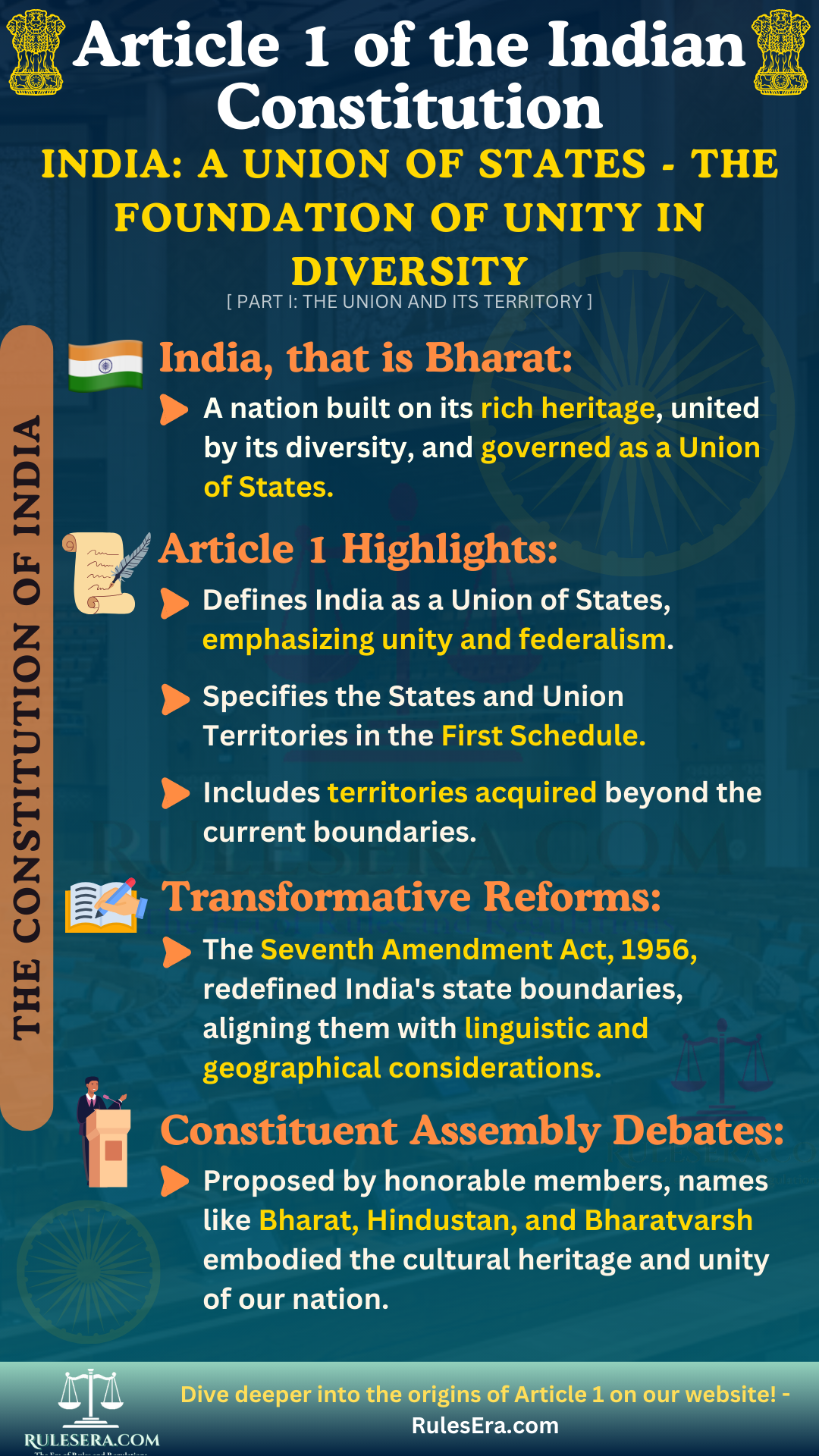Part I: The Union and Its Territory
Article 1: Name and Territory of the Union

Introduction:
Article 1 of the Indian Constitution establishes India as a Union of States, emphasizing its federal structure. This article symbolizes the nation's unity and integrity while acknowledging its diverse states and cultures.
Clause-by-Clause Explanation:
Clause (1): India as a Union of States
India, referred to as Bharat, is officially recognized as a Union of States. This emphasizes the unity and federal structure of the nation.
Clause (2): Specification of States and Territories
The states and their territories are specified in the First Schedule of the Constitution. This clause was revised by the Constitution (Seventh Amendment) Act, 1956, effective 1st November 1956, to provide a detailed enumeration of the states and union territories.
Clause (3): Territorial Composition of India
India's territory includes:
- The territories of the States: All regions governed by individual states.
- The Union Territories as per the First Schedule: As amended by the Constitution (Seventh Amendment) Act, 1956.
- Additional acquired territories: Any new territories acquired by India.
Legislative History:
Article 1 underwent extensive deliberation in the Constituent Assembly in November 1948 and September 1949. It was finalized with significant amendments, including those introduced by the Constitution (Seventh Amendment) Act, 1956, which reorganized Indian states based on linguistic and geographical considerations.
Amendments:
The Constitution (Seventh Amendment) Act, 1956, introduced critical changes to Article 1, implementing the States Reorganisation Scheme. This amendment abolished the classification of states into Part A, B, C, and D categories, redefined state boundaries, and introduced the concept of Union Territories. These changes provided a more cohesive structure to India's territorial organization and governance.
Debates and Deliberations:
The Constituent Assembly engaged in detailed debates on the naming and structure of India:
- H.V. Kamath and Mahboob Ali Baig suggested using "Pradesh" instead of "State" to avoid political connotations. This idea was opposed by Jawaharlal Nehru, who argued "State" was universally understood.
- Maulana Hasrat Mohani opposed the federal structure, advocating for a republic structure. His suggestions were not adopted.
- Shri Kamalapati Tripathi and Seth Govind Das emphasized the cultural significance of the name "Bharat," citing its historical and Vedic roots.
- Prof. K.T. Shah suggested defining territories that might join the Union in the future. His proposal, along with others, was ultimately rejected to ensure clarity and simplicity in constitutional language.
Ultimately, the amended Article 1 was adopted, balancing historical significance with clear constitutional language.
Frequently Asked Questions (FAQs):
Article 1 establishes India as a Union of States, defining the country's federal structure while emphasizing unity and territorial integrity.
The term signifies that the Indian Union is indissoluble, meaning no state has the right to secede, ensuring the integrity of the nation.
The territory of India includes states, Union Territories as listed in the First Schedule, and any other territories acquired in the future.
The Seventh Amendment redefined the boundaries of Indian states and introduced Union Territories, abolishing the earlier classification of states.